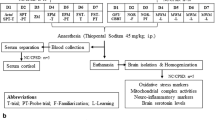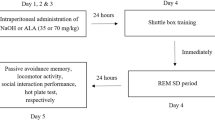Abstract
Rationale
Several clinical studies demonstrate that the absence of periods of sleep is closely related to occurrence of anxiety symptoms. However, the basis of these interactions is poorly understood. Studies performed with animal models of sleep deprivation and anxiety would be helpful in the understanding of the mechanisms underlying this relationship, but some animal studies have not corroborated clinical data, reporting anxiolytic effects of sleep deprivation.
Objectives
The aim of the present study was to verify the effects of different protocols of sleep deprivation in mice tested in the elevated plus-maze and to assess the effect of chlordiazepoxide and clonidine.
Methods
Three-month-old male mice were sleep-deprived for 24 or 72 h using the methods of single or multiple platforms in water tanks. Mice kept in their home cages were used as controls. Plus-maze behavior was observed immediately after the deprivation period.
Results
Mice that were sleep-deprived for 72 h spent a lower percent time in the open arms of the apparatus than control animals. This sleep deprivation-induced anxiety-like behavior was unaffected by treatment with chlordiazepoxide (5.0 and 7.5 mg/kg IP), but reversed by an administration of 5 or 10 μg/kg IP clonidine.
Conclusion
The results indicate that under specific methodological conditions sleep deprivation causes an increase in anxiety-like behavior in mice exposed to the elevated plus-maze.




Similar content being viewed by others
References
Albert I, Cicala GA, Siegel J (1970) The behavioral effects of REM sleep deprivation in rats. Psychophysiology 6:550–560
American Psychiatry Association (1994) Diagnostic statistical manual of mental disorders, 4th edn. APA, Washington D.C.
Bourdet C, Goldenberg F (1994) Insomnia in anxiety: sleep EEG changes. J Psychosom Res 38:93–104
Coenen AML, Van Hulzen ZJM (1980) Paradoxical sleep deprivation in animal studies: some methodological considerations. In: McConnell, Boer GJ, Romjin HJ, Van de Poss NE, Corner MA (eds) Adaptive capabilities of the nervous system (Progress in Brain Research, vol 53). Elsevier, Amsterdam, pp 325–330
Dahl RE, Lewin DS (2002) Pathways to adolescent health sleep regulation and behavior. J Adolesc Health 31:175–184
Dinges DF, Pack F, Williams D, Gillen KA, Powell JW, Ott GE, Pack AI (1997) Cumulative sleepiness, mood disturbances, and psychomotor vigillance performance decrements during a week of sleep restricted to 4–5 hours per night. Sleep 20:267–277
File SE, Zangrossi H Jr, Viana M, Graeff F (1993) Trial 2 in the elevated plus-maze: a different form of fear. Psychopharmacology 111:491–494
Frussa-Filho R, Ribeiro R De A (2002) One-trial tolerance to the effects of chlordiazepoxide in the elevated plus-maze is not due to acquisition of a phobic avoidance of open arms during initial exposure. Life Sci 71:519–525
Frussa-Filho R, Barbosa-Júnior H, Silva RH, Cunha C, Mello CF (1999) Naltrexone potentiates the anxiolytic effect of chlordiazepoxide in rats exposed to novel environments. Psychopharmacology 147:168–173
Gentsch C, Lichtsteiner M, Feer H (1987) Open field and elevated plus-maze: a behavioral comparison between spontaneously hypertensive (SHR) and Wistar Kyoto (WKY) rats and the effects of chlordiazepoxide. Behav Brain Res 25:101–107
Gerner RH, Post RM, Gillin C, Bunney WE Jr (1979) Biological and behavioral effects of one night’s sleep deprivation in depressed patients and normals. J Psychiatr Res 15:21–40
Goto SH, Conceição IM, Ribeiro RA, Frussa-Filho R (1993) Comparison of anxiety measured in the elevated plus-maze, open-field and social interaction tests between spontaneously hypertensive rats and Wistar EPM-1 rats. Braz J Med Biol Res 26:965–969
Gottileb DJ, Peterson CA, Parenti CM, Lofgren RP (1993) Effects of a night float system on house staff neuropsychologic function. J Gen Int Med 8:146–148
Handley SL, Mithani S (1984) Effects of alpha2-adrenoceptor agonists and antagonists in a maze-exploration model of fear-motivated behavior. Naunyn Schmiedeberg′s Arch Pharmacol 327:1–5
Hicks RA, Adams G (1976) REM sleep deprivation and exploration in young rats. Psychol Rep 38:1154
Hipólide DC, Tufik S, Raymond R, Nobrega JN (1998) Heterogenous effects of rapid eye movement sleep deprivation on binding to alpha- and beta-adrenergic receptor subtypes in rat brain. Neuroscience 86:977–987
Hogg S (1996) A review of the validity and variability of the elevated plus-maze as an animal model of anxiety. Pharmacol Biochem Behav 54:21–30
Jouvet D, Vimont P, Delorme F, Jouvet M (1964) Etude de la privation sélective de la phase paradoxale de sommeil chez le chat. C R Soc Biol (Paris) 158:756–759
Koolhaas JM, Meerlo P, de Boer SF, Strubbe JH, Bohus B (1997) The temporal dynamics of the stress response. Neurosci Biobehav Rev 21:775–782
Kushida CA, Bergmann BM, Rechtschaffen A (1989) Sleep deprivation in the rat. IV. Paradoxical sleep deprivation. Sleep 12:22–30
Labatte LA, Johnson MR, Lydiard RB, Brawman-Mintzer O, Emmanuel N, Crawford M, Kapp R, Ballenger JC (1998) Sleep deprivation in social phobia and generalized anxiety disorder. Biol Psychiatry 43:840–842
Larsen JK, Lindberg ML, Skovgaard B (1976) Sleep deprivation as treatment for endogenous depression. Acta Psychiatr Scand 54:167–173
Ledoux L, Sastre JP, Buda C, Luppi PH, Jouvet M (1996) Alterations in c-fos expression after different experimental procedures of sleep deprivation in the cat. Brain Res 735:108–118
Lister RG (1987) The use of a plus-maze to measure anxiety in the mouse. Psychopharmacology 92:180–185
Lourenzi VPM, Gabriel A Jr, Nunes G Jr, Atra E, Tufik S (1993) REM sleep deprivation and social isolation accelerate autoimmune disease in mice. Sleep Res 22:338
Mendelson WB, Guthrie RD, Frederick G, Wyatt RJ (1974) The flower pot technique of rapid eye movement (REM) sleep deprivation. Pharmacol Biochem Behav 2:553–556
Moser PC (1989) An evaluation of the elevated plus-maze test using the novel anxiolytic buspirone. Psychopharmacology 99:48–53
Nunes GP, Tufik S (1994) Validation of the modified multiple platform method (MMP) of paradoxical sleep deprivation in rats. Sleep Res 22:339
Patchev V, Felszeghy K, Korányi L (1991) Neuroendocrine and neurochemical consequences of a long-term sleep deprivation in rats: similarities to some features of depression. Homeostasis 33:97–108
Peeke SC, Callaway E, Jones RT, Stone GC, Doyle J (1980) Combined effects of alcohol and sleep deprivation in normal young adults. Psychopharmacology 67:279–287
Pellow S, Chopin P, File SE, Briley M (1985) Validation of open:closed arm entries in an elevated plus-maze as a measure of anxiety in the rats. J Neurosci Meth 14:149–167
Pereira JK, Vieira RJ, Konishi CT, Ribeiro R de A, Frussa-Filho R (1999) The phenomenon of one-trial tolerance to the anxiolytic effect of chlordiazepoxide in the elevated plus maze is abolished by the introduction of a motivational conflict situation. Life Sci 65:101–107
Pokk P, Vali M (2001) Small platform stress increases exploratory activity of mice in staircase test. Prog Neuropsychopharmacol Biol Psychiatry 25:1435–1444
Pokk P, Zharkoversusky A (1995) The effects of drugs acting at GABA–benzodiazepine–barbiturate receptor complex on the behavior of sleep deprived mice. Pharmacol Toxicol 76:23–28
Pokk P, Zharkoversusky A (1997) The effects of flumazenil, RO 15-4513 and β-CCM on the behaviour of control and stressed mice in the plus-maze test. J Physiol Pharmacol 48:253–261
Pokk P, Zharkoversusky A (1998) Small platform stress attenuates the anxiogenic effect of diazepam withdrawal in the plus-maze test. Behav Brain Res 97:153–157
Pokk P, Liljequist S, Zharkoversusky A (1996) Ro 15-4513 potentiates, instead of antagonizes, ethanol-induced sleep in mice exposed to small platform stress. Eur J Pharmacol 317:15–20
Roy-Byrne PP, Uhde TW, Post RM (1986) Effects of one night’s sleep deprivation on mood and behavior in panic disorder. Arch Gen Psychiatry 43:895–899
Seabra MLV, Tufik S (1993) Sodium diclofenac inhibits hyperthermia induced by paradoxical sleep deprivation: the possible participation of prostaglandins. Physiol Behav 54:923–926
Serra M, Pisu MG, Littera M, Papi G, Sanna E, Tuveri F, Usala L, Purdy RH, Biggio G (2000) Social isolation-induced decreases in both the abundance of neuroactive steroids and GABA(A) receptor function in rat brain. J Neurochem 75:732–740
Silva RH, Frussa-Filho R (2000) The plus-maze discriminative avoidance task: a new model memory–anxiety interactions. Effects of chlordiazepoxide and caffeine. J Neurosci Meth 102:117–125
Silva RH, Frussa-Filho R (2002) Naltrexone potentiates both amnestic and anxiolytic effects of chlordiazepoxide in mice. Life Sci 72:721–730
Silva RH, Kameda SR, Carvalho RC, Rigo GS, Costa KLB, Taricano ID, Frussa-Filho R (2002) Effects of amphetamine on the plus-maze discriminative avoidance task in mice. Psychopharmacology 160:9–18
Silva RH, Abílio VC, Takatsu AL, Kameda SR, Grassl C, Chehin AB, Medrano WA, Calzavara MB, Registro S, Andersen ML, Machado RB, Carvalho RC, Ribeiro R de A, Tufik S, Frussa-Filho R (2004) Role of hippocampal oxidative stress in memory deficits induced by sleep deprivation in mice. Neuropharmacology 46:895–903
Söderpalm B, Engel JÁ (1988) Biphasic effects of clonidine on conflict behavior: involvement of different alpha-adrenoceptors. Pharmacol Biochem Behav 30:471–477
Suchecki D, Tufik S (2000) Social stability attenuates the stress in the modified multiple platform method for paradoxical sleep deprivation in the rat. Physiol Behav 68:309–316
Suchecki D, Tiba PA, Tufik S (2002) Hormonal and behavioural responses of paradoxical sleep-deprived rats to the elevated plus-maze. J Neuroendocrinol 14:549–554
Svendsen K (1976) Sleep deprivation therapy in depression. Acta Psychiatr Scand 54:184–192
Timo-Iaria C, Negrão N, Schmidek WR, Rocha TL, Hoshino K (1970) Phases and states of sleep in the rat. Physiol Behav 5:402–407
Tufik S, Trocone LRP, Braz S, Silva-Filho AR, Neumann BG (1987) Does REM sleep deprivation induce subsensitivity of pre-synaptic dopamine of postsynaptic acetylcholine receptors in the brain? Eur J Pharmacol 140:215–219
Tufik S, Nathan CL, Neumann B, Hipólide DC, Lobo LL, Medeiros R, Trocone LRP, Braz S, Suchecki D (1995) Effects of stress on drug-induced yawning: constant versus intermittent stress. Physiol Behav 58:181–184
Van den Burg W, Van den Hoofdakker RH (1975) Total sleep deprivation on endogenous depression. Arch Gen Psychiatry 32:1121–1125
Van Hulzen ZJM, Coenen AML (1981) Paradoxical sleep deprivation and locomotor activity in rats. Physiol Behav 27:741–744
Vovin RIA, Fakturovich AIA (1985) Sleep deprivation as a method of treating endogenous depression. Zh Nevropatol Psikhiatr Im S S Korsakova 85:560–565
Wyatt RJ, Fram DH, Kupfer DJ, Snyder F (1971) Total prolonged drug-induced REM sleep suppression in anxious-depressed patients. Arch Gen Psychiatry 24:145–155
Acknowledgements
This research was supported by fellowship from Fundação de Amparo a Pesquisa do Estado de São Paulo (FAPESP: proc. CEPID 98/14303-3 and proc. 01/10713-7), from Conselho Nacional de Desenvolvimento Científico e Tecnológico CNPq: proc. 522975/95-0), from Fundo de Auxílio ao Docente e Aluno da UNIFESP (FADA) and from Associação Fundo de Incentivo à Psicofarmacologia (AFIP). The authors would like to thank Ms. Teotila R.R. Amaral and Mr. Cleomar S. Ferreira for capable technical assistance.
Author information
Authors and Affiliations
Corresponding author
Rights and permissions
About this article
Cite this article
Silva, R.H., Kameda, S.R., Carvalho, R.C. et al. Anxiogenic effect of sleep deprivation in the elevated plus-maze test in mice. Psychopharmacology 176, 115–122 (2004). https://doi.org/10.1007/s00213-004-1873-z
Received:
Accepted:
Published:
Issue Date:
DOI: https://doi.org/10.1007/s00213-004-1873-z




